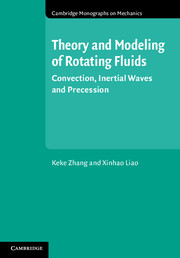Refine search
Actions for selected content:
8124 results in Fluid dynamics and solid mechanics
13 - Shaped-charge (Munroe) Jets and Projectile Penetration
- from Part V - Solid–Solid Collisions
-
- Book:
- Collision Phenomena in Liquids and Solids
- Published online:
- 13 July 2017
- Print publication:
- 15 June 2017, pp 515-565
-
- Chapter
- Export citation

Theory and Modeling of Rotating Fluids
- Convection, Inertial Waves and Precession
-
- Published online:
- 26 May 2017
- Print publication:
- 23 May 2017
IMAGE INPAINTING FROM PARTIAL NOISY DATA BY DIRECTIONAL COMPLEX TIGHT FRAMELETS
- Part of
-
- Journal:
- The ANZIAM Journal / Volume 58 / Issue 3-4 / April 2017
- Published online by Cambridge University Press:
- 26 May 2017, pp. 247-255
-
- Article
-
- You have access
- Export citation
SCHEDULING ON TWO PARALLEL MACHINES WITH TWO DEDICATED SERVERS
- Part of
-
- Journal:
- The ANZIAM Journal / Volume 58 / Issue 3-4 / April 2017
- Published online by Cambridge University Press:
- 25 May 2017, pp. 314-323
-
- Article
-
- You have access
- Export citation
PARALLEL MACHINE SCHEDULING WITH JOB DELIVERY COORDINATION
- Part of
-
- Journal:
- The ANZIAM Journal / Volume 58 / Issue 3-4 / April 2017
- Published online by Cambridge University Press:
- 25 May 2017, pp. 306-313
-
- Article
-
- You have access
- Export citation
COVERAGE PERFORMANCE OF COGNITIVE RADIO NETWORKS POWERED BY RENEWABLE ENERGY
- Part of
-
- Journal:
- The ANZIAM Journal / Volume 58 / Issue 3-4 / April 2017
- Published online by Cambridge University Press:
- 24 May 2017, pp. 287-305
-
- Article
-
- You have access
- Export citation
ON MULTI-ASSET SPREAD OPTION PRICING IN A WICK–ITÔ–SKOROHOD INTEGRAL FRAMEWORK
- Part of
-
- Journal:
- The ANZIAM Journal / Volume 58 / Issue 3-4 / April 2017
- Published online by Cambridge University Press:
- 24 May 2017, pp. 386-396
-
- Article
-
- You have access
- Export citation
NEW GENERALIZED
 $h$ -IMPLICATIONS
$h$ -IMPLICATIONS
- Part of
-
- Journal:
- The ANZIAM Journal / Volume 58 / Issue 3-4 / April 2017
- Published online by Cambridge University Press:
- 24 May 2017, pp. 276-286
-
- Article
-
- You have access
- Export citation
Part 4 - Convection in Uniformly Rotating Systems
-
- Book:
- Theory and Modeling of Rotating Fluids
- Published online:
- 26 May 2017
- Print publication:
- 23 May 2017, pp 297-298
-
- Chapter
- Export citation
Part 2 - Inertial Waves in Uniformly Rotating Systems
-
- Book:
- Theory and Modeling of Rotating Fluids
- Published online:
- 26 May 2017
- Print publication:
- 23 May 2017, pp 15-16
-
- Chapter
- Export citation
9 - Introduction
- from Part 3 - Precession and Libration in Non-uniformly Rotating Systems
-
- Book:
- Theory and Modeling of Rotating Fluids
- Published online:
- 26 May 2017
- Print publication:
- 23 May 2017, pp 129-137
-
- Chapter
- Export citation
Frontmatter
-
- Book:
- Theory and Modeling of Rotating Fluids
- Published online:
- 26 May 2017
- Print publication:
- 23 May 2017, pp i-iv
-
- Chapter
- Export citation
6 - Inertial Modes in Rotating Oblate Spheroids
- from Part 2 - Inertial Waves in Uniformly Rotating Systems
-
- Book:
- Theory and Modeling of Rotating Fluids
- Published online:
- 26 May 2017
- Print publication:
- 23 May 2017, pp 83-104
-
- Chapter
- Export citation
Contents
-
- Book:
- Theory and Modeling of Rotating Fluids
- Published online:
- 26 May 2017
- Print publication:
- 23 May 2017, pp v-x
-
- Chapter
- Export citation
14 - Fluid Motion in Precessing Oblate Spheroids
- from Part 3 - Precession and Libration in Non-uniformly Rotating Systems
-
- Book:
- Theory and Modeling of Rotating Fluids
- Published online:
- 26 May 2017
- Print publication:
- 23 May 2017, pp 250-275
-
- Chapter
- Export citation
10 - Fluid Motion in Precessing Narrow-gap Annuli
- from Part 3 - Precession and Libration in Non-uniformly Rotating Systems
-
- Book:
- Theory and Modeling of Rotating Fluids
- Published online:
- 26 May 2017
- Print publication:
- 23 May 2017, pp 138-163
-
- Chapter
- Export citation
8 - Indications of Completeness of Inertial Modes in Rotating Spheres
- from Part 2 - Inertial Waves in Uniformly Rotating Systems
-
- Book:
- Theory and Modeling of Rotating Fluids
- Published online:
- 26 May 2017
- Print publication:
- 23 May 2017, pp 118-126
-
- Chapter
- Export citation
Part 3 - Precession and Libration in Non-uniformly Rotating Systems
-
- Book:
- Theory and Modeling of Rotating Fluids
- Published online:
- 26 May 2017
- Print publication:
- 23 May 2017, pp 127-128
-
- Chapter
- Export citation
18 - Convection in Rotating Cylinders
- from Part 4 - Convection in Uniformly Rotating Systems
-
- Book:
- Theory and Modeling of Rotating Fluids
- Published online:
- 26 May 2017
- Print publication:
- 23 May 2017, pp 396-438
-
- Chapter
- Export citation
Preface
-
-
- Book:
- Theory and Modeling of Rotating Fluids
- Published online:
- 26 May 2017
- Print publication:
- 23 May 2017, pp xi-xiv
-
- Chapter
- Export citation
















